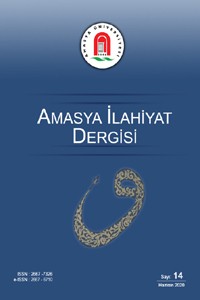Öz
Anahtar Kelimeler
Arabic Language and Literature Andalusia Istighāsah Bāyezid II Qasīdah
Kaynakça
- Abdulbâkî Muhammed, Abdulbâkî Hüseyn. “Sînîyyetü İbni’l-Abbâr -dirâse belâğiyye nakdiyye-“. Mecelletü Külliyeti’l-Lügati’l-Arabiyye bi Asyût 30/4 (Aralık 2011), 2293-2341.
- Anân, Muhammed Abdullâh. Devletü’l-İslâm fi’l-Endelüs. 4 Cilt. Kahire: Mektebetü’l-Hanicî, 1997.
- Bilgin, Feridun. ‘’Gırnata İşgali Sonrasında Endülüs’teki Müslümanların Asimilasyonu’’. Mukaddime Dergisi 2 (2010), 53-78.
- Ferâhîdî, Halîl b. Ahmed. Kitâbu’l-ʻayn. thk. Mehdî el-Mahzûmî - İbrâhîm es-Samerrâî. 4 Cilt. Lübnan: Dâru ve Mektebetü’l-Hilâl, ts.
- Goran, Selahattin. Endülüs Arap Şiirinde Vatan Özlemi. Ankara: Ankara Üniversitesi, Sosyal Bilimler Enstitüsü, Doktora Tezi, 2003.
- İbn Dureyd, Ebû Bekr Muhammed el-Ezdî. Cemheretü’l-lüğa. thk. Remzî Munîr Baʿlebekkî. Beyrut: Dâru’l-İlmi li’l-Melâyîn, 1407/1987.
- İbn Mâlik et-Tâî, Ebû Abdillâh Cemâlüddîn Muhammed b. Abdillâh el-Endelüsî el-Ceyyânî. el-Elfâzu’l-Muhtelifetü fî’l-Meâni’l-Mu’telife. thk. Muhammed Hasan Avâd. Beyrut: Dâru’l-Cîl, 1411/1991.
- Îsâ, Fevzî. eş-Şiʻri’l-Endelüsî fî asri’l-Muvahhidin. İskenderiyye: Dâru’l-Vefâ, 1428/2007.
- Kasapoğlu, Abdurrahman. “Kur’an’da Dini Bir Tecrübe Olarak Allah’tan Yardım Dileme ve O’na Muhtaçlık “İstiâne”, “İstiğâse” ve “Fakr İla’llâh”. İnönü Üniversitesi İlahiyat Fakültesi Dergisi 5/2 (Güz 2014), 81-127.
- Makkarî, Şihâbuddîn Ahmed b. Muhammed el-Tilimsânî. Ezhâru’r-riyâd fi ehbâri el-Kâdî ʻİyâd. thk. Mustafa es-Sekkâ vd.. 3 Cilt. Kahire: Matbaʻâtu Lecneti’t-Te’lîf, 1358/1939.
- Merrâküşî, Ebû ʻAbdullah Muhammed b. ʻAbdulmelik el-Ensârî. ez-Zeyl ve’t-tekmile lî kitâbi’l-mevsûl ve’s-sıla. thk. İhsân ʻAbbâs vd.. 4 Cilt. Tunus: Dâru’l-Ğarbi’l-İslâmî, 1433/2012.
- Mekkî, Tahir Ahmed. Dirâsât Endelüsiyye fî’l-edeb ve’t-târîh ve’l-felsefe. Kahire: Dârü Maârif, 1407/1987.
- Sâmerrâî, Halîl İbrâhîm vd.. Târîhü’l-Arab ve Hadaratuhum fî’l-Endelüs. Beyrut: Dâru’l-Kitâbi’l-Cedîdi’l-Muttehide, 1421/2000.
- Şeyban, Lütfi. “Hıristiyan İşgalinde Endülüs Şehirleri”. Eski Yeni: 3 Aylık Düşünce Dergisi 1 (Bahar 2006), 29.
- Özdemir, Mehmet. “Gırnata”. Türkiye Diyanet Vakfı İslam Ansiklopedisi. 14/51-57. İstanbul: TDV Yayınları, 1996.
- Özdemir, Mehmet. “Endülüs”. Türkiye Diyanet Vakfı İslam Ansiklopedisi. 11/211-225. İstanbul: TDV Yayınları, 1995.
- Özdemir, Mehmet. “Morisko”. Türkiye Diyanet Vakfı İslam Ansiklopedisi. 30/288-291. İstanbul: TDV Yayınları, 2005.
- Özdemir, Mehmet. “Müdeccenler”. Türkiye Diyanet Vakfı İslam Ansiklopedisi. 31/465-467. İstanbul: TDV Yayınları, 2006.
- Özdemir, Mehmet. “Osmanlı Endülüs Müslümanlarına Yardım Etmedi mi?”. İslâmî Araştırmalar Dergisi 12/3-4 (1999), 283-296.
- Uzunçarşılı, İsmail Hakkı. Osmanlı Tarihi. 2 Cilt. Ankara: Türk Dil Kurumu Basımevi, 1988.
- Yiğit, İsmail. “Nasriler”. Türkiye Diyanet Vakfı İslam Ansiklopedisi. 32/420-424. İstanbul: TDV Yayınları, 2006.
- Yüksel, Azmi. “Endülüs’ten II. Bayezid’a Anonim Bir Şiir”. Belleten 3/205 (Aralık 1988), 1576-1583.
- Zebîdî, Muhammed b. ʻAbdurrezzâk el-Hüseynî Ebü’l-Feyd. “Tâcu’l-arûs min cevâhiri’l-kâmûs. thk. ʻAlî Hilâlî. 5 Cilt. Kuveyt: Matbaʻâtü Hukûmeti’l-Kuveyt, 1423/2003.
Öz
Anahtar Kelimeler
Kaynakça
- Abdulbâkî Muhammed, Abdulbâkî Hüseyn. “Sînîyyetü İbni’l-Abbâr -dirâse belâğiyye nakdiyye-“. Mecelletü Külliyeti’l-Lügati’l-Arabiyye bi Asyût 30/4 (Aralık 2011), 2293-2341.
- Anân, Muhammed Abdullâh. Devletü’l-İslâm fi’l-Endelüs. 4 Cilt. Kahire: Mektebetü’l-Hanicî, 1997.
- Bilgin, Feridun. ‘’Gırnata İşgali Sonrasında Endülüs’teki Müslümanların Asimilasyonu’’. Mukaddime Dergisi 2 (2010), 53-78.
- Ferâhîdî, Halîl b. Ahmed. Kitâbu’l-ʻayn. thk. Mehdî el-Mahzûmî - İbrâhîm es-Samerrâî. 4 Cilt. Lübnan: Dâru ve Mektebetü’l-Hilâl, ts.
- Goran, Selahattin. Endülüs Arap Şiirinde Vatan Özlemi. Ankara: Ankara Üniversitesi, Sosyal Bilimler Enstitüsü, Doktora Tezi, 2003.
- İbn Dureyd, Ebû Bekr Muhammed el-Ezdî. Cemheretü’l-lüğa. thk. Remzî Munîr Baʿlebekkî. Beyrut: Dâru’l-İlmi li’l-Melâyîn, 1407/1987.
- İbn Mâlik et-Tâî, Ebû Abdillâh Cemâlüddîn Muhammed b. Abdillâh el-Endelüsî el-Ceyyânî. el-Elfâzu’l-Muhtelifetü fî’l-Meâni’l-Mu’telife. thk. Muhammed Hasan Avâd. Beyrut: Dâru’l-Cîl, 1411/1991.
- Îsâ, Fevzî. eş-Şiʻri’l-Endelüsî fî asri’l-Muvahhidin. İskenderiyye: Dâru’l-Vefâ, 1428/2007.
- Kasapoğlu, Abdurrahman. “Kur’an’da Dini Bir Tecrübe Olarak Allah’tan Yardım Dileme ve O’na Muhtaçlık “İstiâne”, “İstiğâse” ve “Fakr İla’llâh”. İnönü Üniversitesi İlahiyat Fakültesi Dergisi 5/2 (Güz 2014), 81-127.
- Makkarî, Şihâbuddîn Ahmed b. Muhammed el-Tilimsânî. Ezhâru’r-riyâd fi ehbâri el-Kâdî ʻİyâd. thk. Mustafa es-Sekkâ vd.. 3 Cilt. Kahire: Matbaʻâtu Lecneti’t-Te’lîf, 1358/1939.
- Merrâküşî, Ebû ʻAbdullah Muhammed b. ʻAbdulmelik el-Ensârî. ez-Zeyl ve’t-tekmile lî kitâbi’l-mevsûl ve’s-sıla. thk. İhsân ʻAbbâs vd.. 4 Cilt. Tunus: Dâru’l-Ğarbi’l-İslâmî, 1433/2012.
- Mekkî, Tahir Ahmed. Dirâsât Endelüsiyye fî’l-edeb ve’t-târîh ve’l-felsefe. Kahire: Dârü Maârif, 1407/1987.
- Sâmerrâî, Halîl İbrâhîm vd.. Târîhü’l-Arab ve Hadaratuhum fî’l-Endelüs. Beyrut: Dâru’l-Kitâbi’l-Cedîdi’l-Muttehide, 1421/2000.
- Şeyban, Lütfi. “Hıristiyan İşgalinde Endülüs Şehirleri”. Eski Yeni: 3 Aylık Düşünce Dergisi 1 (Bahar 2006), 29.
- Özdemir, Mehmet. “Gırnata”. Türkiye Diyanet Vakfı İslam Ansiklopedisi. 14/51-57. İstanbul: TDV Yayınları, 1996.
- Özdemir, Mehmet. “Endülüs”. Türkiye Diyanet Vakfı İslam Ansiklopedisi. 11/211-225. İstanbul: TDV Yayınları, 1995.
- Özdemir, Mehmet. “Morisko”. Türkiye Diyanet Vakfı İslam Ansiklopedisi. 30/288-291. İstanbul: TDV Yayınları, 2005.
- Özdemir, Mehmet. “Müdeccenler”. Türkiye Diyanet Vakfı İslam Ansiklopedisi. 31/465-467. İstanbul: TDV Yayınları, 2006.
- Özdemir, Mehmet. “Osmanlı Endülüs Müslümanlarına Yardım Etmedi mi?”. İslâmî Araştırmalar Dergisi 12/3-4 (1999), 283-296.
- Uzunçarşılı, İsmail Hakkı. Osmanlı Tarihi. 2 Cilt. Ankara: Türk Dil Kurumu Basımevi, 1988.
- Yiğit, İsmail. “Nasriler”. Türkiye Diyanet Vakfı İslam Ansiklopedisi. 32/420-424. İstanbul: TDV Yayınları, 2006.
- Yüksel, Azmi. “Endülüs’ten II. Bayezid’a Anonim Bir Şiir”. Belleten 3/205 (Aralık 1988), 1576-1583.
- Zebîdî, Muhammed b. ʻAbdurrezzâk el-Hüseynî Ebü’l-Feyd. “Tâcu’l-arûs min cevâhiri’l-kâmûs. thk. ʻAlî Hilâlî. 5 Cilt. Kuveyt: Matbaʻâtü Hukûmeti’l-Kuveyt, 1423/2003.
Ayrıntılar
| Birincil Dil | Türkçe |
|---|---|
| Konular | Din Araştırmaları |
| Bölüm | Araştırma Makaleleri |
| Yazarlar | |
| Yayımlanma Tarihi | 30 Haziran 2020 |
| Yayımlandığı Sayı | Yıl 2020 Sayı: 14 |
Cited By
Amasya İlahiyat Dergisi-Amasya Theology Journal Creative Commons Alıntı-GayriTicari-Türetilemez 4.0 Uluslararası Lisansı ile lisanslanmıştır.


